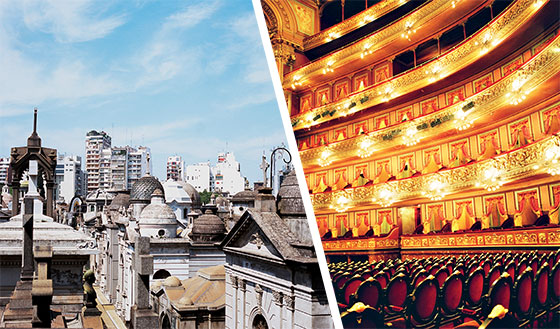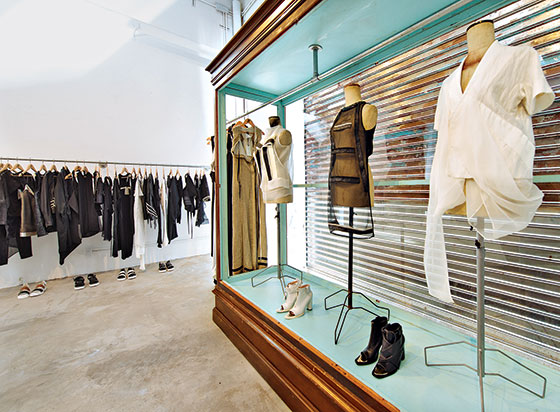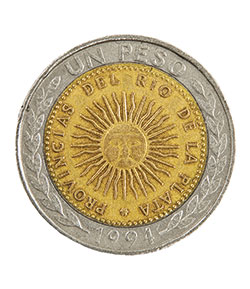 |
Cementerio de la Recoleta and Teatro Colón
(Photo: Aaron McCoy/Getty Images (Cemeterio)/ Joao Canziani/Getty Images (Teatro)) |
The Alt Pope Tour
Lower-key papal tourists who’d rather not take a three-hour bus tour of the city’s churches and seminaries can still get a glimpse into the former life of this humble man-about-town by taking small detours at B.A.’s biggest attractions.
Plaza de Mayo, the main square in Monserrat, in eastern B.A., is flanked by the Casa Rosada and the Greek Revival Catedral Metropolitana, where Francis served as archbishop. Less ogled: the offices of the archdiocese, where the pope lived in a one-room apartment instead of the episcopal palace, and the news kiosk across the plaza, where he would pick up a copy of La Nación every day, save the rubber bands, and then return them each month in a ball.
The high-ceilinged barbershop where the pope got his hair cut for 20 years, called Peluquería Romano, sits among other shops along the ground-floor passageway of Pasaje Roverano (Avenida de Mayo 560). Stop for a snack of churros and hot chocolate among the oak-paneled walls and green marble tables at literary hangout Café Tortoni (Avenida de Mayo 825).
Continuing on Avenida de Mayo, you’ll come to Avenida 9 de Julio, where a few blocks to the right is Plaza de la República, anchored by the Obelisco and then the Teatro Colón (Cerrito 628) opera house. Go straight, and you’ll come to Congreso Nacional (Avenida Rivadavia 1864), where the then�Cardinal Bergoglio encouraged the faithful to protest a 2010 bill to legalize same-sex unions�though he may have privately attempted to get the church to support it.
Upon exiting the famed Cementerio de la Recoleta, where you’ll walk among the towering family tombs that hold Nobel Prize winners and Eva Perón, you’ll see the Centro Cultural Recoleta (Junín 1930). It was here, in 2004, that Bergoglio demanded that a �blasphemous� exhibit by artist León Ferrari�which depicted images of Catholic saints in a frying pan and the Virgin Mary in a blender�be shut down.
Backless Blouses and Bone Jewelry
Instead of boutique-hopping in Palermo, head to Villa Crespo, the emerging neighborhood bordering the traditional retail hub. Personal shopper Vanessa Bell picks out four stores that won’t be flooded with tourists.
 |
JT by JT
(Photo: Courtesy of the vendor) |
Outré Dresses
JT by JT
Humboldt 291
�All of Jessica Trosman’s avant-garde pieces�asymmetrical silk dresses, metallic backless tops�are produced on-site at her store and run in the $500-to-$1,000 range.�
Organ Jewelry
Marina Molinelli Wells and Soledad Kussrow
Padilla 1261, doorbell 1
�Two jewelry designers who share a hidden studio space on a quiet, leafy street. Marina’s Cabinet Óseo designs incorporate organs and bones, while animals are key to Soledad’s jewelry, with bear rings and bird silhouettes.�
Bondage Shorts
Benitez Emilse
Presidente Fragata Sarmiento 2071
�Emilse’s bondage-style leather accessories with studs and chains are for both men and women and could almost be considered works of art. She makes some great leather shorts.�
Niche Books
La Internacional Argentina
Padilla 865
�This bookshop doubles as the headquarters of indie publishing house Mansalva. They sell rare and hard-to-find tomes and first editions and hold regular book parties and readings, where wine flows and festivities go on till late.�
City Walls
Buenos Aires has a long history of giving street artists free rein over its boarded-up buildings and abandoned warehouses. Cecilia Quiles of Graffitimundo (an organization promoting B.A.’s vibrant graffiti scene) offers four of the best mural-ogling spots.
Giant mural by Doma + Fase
Corner of Río Limay and Pedro de Luján, Barracas
�Following Argentina’s economic crisis in 2001, the city plunged into a deep depression. Art collectives like Doma and Fase painted abstract pieces and cartoonish characters in bold primary colors to bring color and positivity back to the streets.�
�Salta y Teta,� by JAZ
Corner of Cramer and Benjamín Matienzo, Colegiales
�Jaz is one of the best-known Argentine street artists. He spends a large part of the year traveling the world, painting at festivals and working on huge art projects, but when he is back in the city, he still paints walls around Villa Crespo and Chacarita with his friends.�
Hollywood in Cambodia
Thames 1885, Palermo
�The city’s first and most important street-art gallery, housed in the back of a bar on Thames 1885.�
Murals by Blu, Martin Ron, and many others
Corner of Holmberg and Dr. Pedro Ignacio Rivera, Villa Urquiza
�Since the ’90s, artists have come here to paint the ruins of the abandoned and semi-demolished buildings. In 2007, Italian artist Blu painted an incredible mural on a vacant lot�at the time it was one of the biggest he had painted. Five years later, the city government decided to �polish up’ the mural by painting the background a uniform light gray, destroying the context in which the artist had created his great work of art.�
 |
(Photo: Grotmarse/Getty Images) |
How to Go Blue
When the government imposed tight restrictions on the purchase of foreign money in 2011, explains economist Jorge Herrera, Argentines looked for ways to circumvent the system, and a technically illegal underground currency market known as the �blue dollar� emerged. Argentines and foreigners alike seek out the black-market exchanges; locals in order to have trustworthy dollars on hand, and tourists for a way-better exchange rate (last we checked, the official rate was 8.52 pesos to the dollar, while the blue rate hit 15.1). Here, a glossary to help navigate the currency-scape.
Arbolitos: Street-currency sellers. You’ll find them along Florida Street yelling, �Cambio, cambio!� Anyone can buy or sell currency through them.
Cuevas: Currency-exchange offices that operate in the illegal market. When dealing with an arbolito, he will take you to one of these for the actual exchange of money.
Lanacion.com: The newspaper site to visit to keep up with the blue rate, which fluctuates like crazy.
Cash: Contrary to what every travel book advises, bring a lot of it with you.